

Carbohydrates. Protein. Fats (Lipids) Digestive System (ADW) Zinc. Vitamin E. Vitamin C Vitamin A & Sodium. Vitamin B powerpoint. POTASSIUM PPT. Folate. Heart Foundation Tick. 25 years of Heart Foundation Tick 2014 marks the 25th anniversary of the Heart Foundation Tick Program - a pioneering public health initiative undertaken to help consumers make healthier food choices and to drive critically important changes to the food supply.
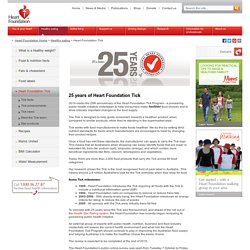
The Tick is designed to help guide consumers towards a healthier product, when compared to similar products, while they’re standing in the supermarket aisle. Tick works with food manufacturers to make foods healthier. We do this by setting strict nutrient standards for foods which manufacturers are encouraged to meet by changing their product recipes. Once a food has met these standards, the manufacturer can apply to carry the Tick logo. This means that all Australians when shopping can easily identify foods that are lower in saturated fat, trans fat, sodium (salt), kilojoules (energy), and which contain more beneficial ingredients like fibre, calcium, wholegrains and vegetables. The Difference Between Vegan and Vegeterain. Glycemic load. Sweetness of various compounds. Coeliac Disease - Coeliac Australia.
Is it important to avoid eating foods high in cholesterol. Functional Foods - calcium, effects, nutrition, deficiency, body, diet, health, protein. Photo by: Alaettin YILDIRIM Functional foods are foods that provide health benefits beyond basic nutrition due to certain physiologically active components, which may or may not have been manipulated or modified to enhance their bioactivity.
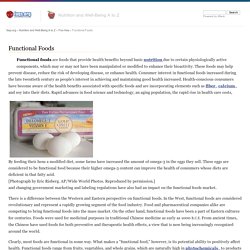
These foods may help prevent disease, reduce the risk of developing disease, or enhance health. Consumer interest in functional foods increased during the late twentieth century as people's interest in achieving and maintaining good health increased. Health-conscious consumers have become aware of the health benefits associated with specific foods and are incorporating elements such as fiber , calcium , and soy into their diets. Rapid advances in food science and technology, an aging population, the rapid rise in health care costs, By feeding their hens a modified diet, some farms have increased the amount of omega-3 in the eggs they sell. [Photograph by Eric Risberg. Clearly, most foods are functional in some way. The Future M. Know your dietary fiber: A guide to soluble and insoluble fiber. Understanding Glycemic Index and Glycemic Load.
Healthy Food Advice : What are Complete Protein Foods? Complementary Proteins: Why You Don't Need Meat to Be Healthy. Good Fats vs. Bad Fats. What Are Trans Fats? The Digestive System [HD Animation] The Digestive System. Diet for Lactose Intolerance. What is lactose intolerance?
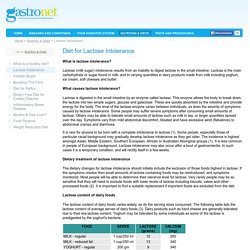
Lactose (milk sugar) intolerance results from an inability to digest lactose in the small intestine. Lactose is the main carbohydrate or sugar found in milk, and in varying quantities in dairy products made from milk including yoghurt, ice cream, soft cheeses and butter. What causes lactose intolerance? Lactose is digested in the small intestine by an enzyme called lactase. This enzyme allows the body to break down the lactose into two simple sugars, glucose and galactose. It is rare for anyone to be born with a complete intolerance to lactose (1). Dietary treatment of lactose intolerance The dietary changes for lactose intolerance should initially include the exclusion of those foods highest in lactose. Lactose content of dairy foods The lactose content of dairy foods varies widely, as do the serving sizes consumed.
The recommended daily intake for calcium is 800 mg for men and the same for women, until menopause. Vitamins & Minerals an Overview. Calcium Rich Diets. Osteoporosis Australia. Calcium Calcium is essential for building and maintaining bone.
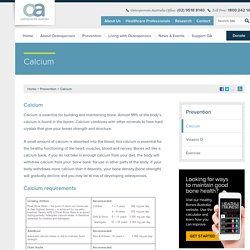
Almost 99% of the body’s calcium is found in the bones. Calcium combines with other minerals to form hard crystals that give your bones strength and structure. Calcium in diet: MedlinePlus Medical Encyclopedia. Calcium is the most plentiful mineral found in the human body.
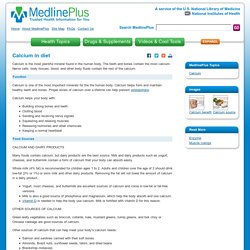
The teeth and bones contain the most calcium. Nerve cells, body tissues, blood, and other body fluids contain the rest of the calcium. Function Calcium is one of the most important minerals for the the human body. Calcium helps form and maintain healthy teeth and bones. Iron Rich Foods: The Essentials of Iron. Nutrition Australia. Iron is a mineral that is found in a range of foods.
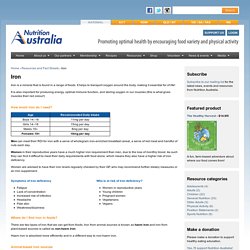
It helps to transport oxygen around the body, making it essential for of life! It is also important for producing energy, optimal immune function, and storing oxygen in our muscles (this is what gives muscles their red colour!) How much iron do I need? Men can meet their RDI for iron with a serve of wholegrain iron-enriched breakfast cereal, a serve of red meat and handful of nuts each day. Women in their reproductive years have a much higher iron requirement than men, due to the loss of monthly blood. Women are advised to have their iron levels regularly checked by their GP, who may recommend further dietary measures or an iron supplement. Where do I find iron in foods? There are two types of iron that we can get from foods. Haem iron is absorbed more efficiently and in a different way to non-haem iron. Animal-based iron sources Plant-based iron sources. Iron fact sheet. Iron. Functional Foods - calcium, effects, nutrition, deficiency, body, diet, health, protein.